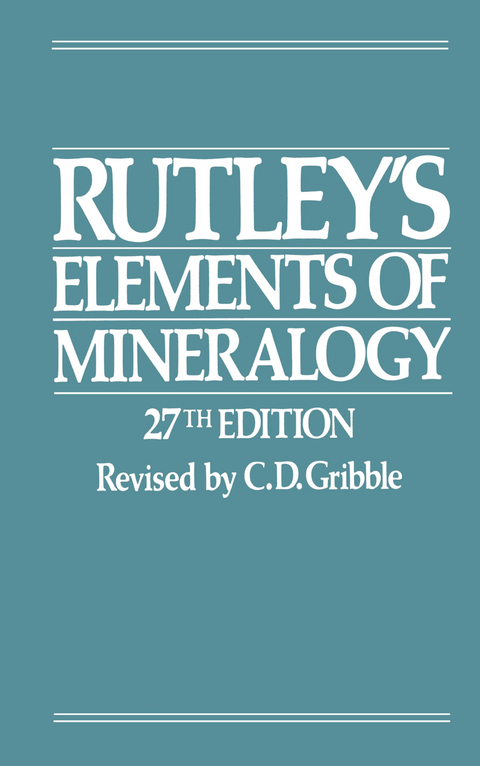
Rutley’s Elements of Mineralogy
Kluwer Academic Publishers (Verlag)
978-0-04-549011-0 (ISBN)
Rutley's elements of mineralogy has been around for a long time, certainly throughout my own lifetime; and if my great grandfather had read geology, it would have been prescribed reading for him too! It has been rewritten and revised frequently since fir~t conceived by Frank Rutley in the late 19th century. Major revisions occurred in 1902, and then in 1914, when H. H. Read first took over the authorship, and thereafter in 1936 and in 1965 when the last major changes occurred. It was with some trepidation that I agreed to attempt this revision. I had been asked to do it by Janet Watson in 1979, but various commitments delayed my start on it until 1984. This 27th edition encompasses a number of changes. Chapters 1-5 have the same headings as before, but considerable changes have been made in all of them, particularly 1, 3, 4 and 5. Comments sought prior to the revision revealed considerable disagreement about the role of blowpipe analyses in the book. I have only once had blowpipe analyses demon strated to me, and have never used them; but there is no doubt that they are employed in many countries, and many of the tests (flame colour, bead, etc. ) are still useful as rapid indicators of which element is present in a mineral. I have therefore kept blowpipe analysis information in Rutley, but have relegated it to an appendix.
1 The chemistry of minerals.- 1.1 States of matter.- 1.2 Elements, compounds and mixtures.- 1.3 Atoms and molecules.- 1.4 Atomic number, valency and atomic weight.- 1.5 Atomic bonding.- 1.6 Ion size and ionic radii.- 1.7 Ionic potential and behaviour of ions in magma.- 1.8 Periodic classification of the elements.- 1.9 Oxides, acids and bases, and salts.- 1.10 Oxidation and reduction.- 1.11 The electrochemical series of metals.- 1.12 Chemical analysis.- 2 Physical properties of minerals.- 2.1 Introduction.- 2.2 Characters dependent upon light.- 2.3 Taste, odour and feel.- 2.4 State of aggregation.- 2.5 Specific gravity.- 2.6 Characters dependent upon heat.- 2.7 Characters dependent upon magnetism, electricity and radioactivity.- 3. The elements of crystallography.- 3.1 Introduction.- 3.2 The internal structure of minerals.- 3.3 The nature of the crystalline state.- 3.4 Stereographic projection.- 3.5 Description of crystals.- 3.6 The crystal systems.- 3.7 Crystal drawings.- 3.8 Simple uses of crystal stereograms.- 4 The optical properties of minerals.- 4.1 Introduction.- 4.2 The nature of light.- 4.3 Reflection.- 4.4 Refraction.- 4.5 The petrological microscope.- 4.6 Isotropic and anisotropic substances.- 4.7 Isotropic minerals.- 4.8 Uniaxial minerals.- 4.9 Biaxial minerals.- 4.10 Pleochroism.- 4.11 Thin sections of rocks and minerals.- 4.12 Systematic description of minerals under the petrological microscope.- 4.13 The microscopic investigation of ore minerals.- 4.14 Microchemical tests.- 4.15 X-ray diffraction studies of minerals.- 5 The occurrence of minerals.- 5.1 Introduction.- 5.2 Classification of rocks.- 5.3 Igneous rocks.- 5.4 Sedimentary rocks.- 5.5 Metamorphic rocks.- 5.6 Mineral deposits.- 5.7 Earth history.- 6 The classification of minerals.- 7 Economic grouping of minerals according to elements.- Ia Lithium, sodium and potassium.- Ib Copper, silver and gold.- IIa Calcium, strontium, barium and radium.- IIb Beryllium, magnesium, zinc, cadmium and mercury.- IIIb Boron and aluminium (gallium, indium).- IVa Titanium, zirconium, cerium and rare earth elements, and thorium.- IVb Carbon, silicon, tin and lead.- Va Vanadium, niobium and tantalum.- Vb Nitrogen, phosphorus, arsenic, antimony and bismuth.- VIa Chromium, molybdenum, tungsten and uranium.- VIb Sulphur, selenium and tellurium.- VIIa Manganese and rhenium.- Vllb Fluorine, chlorine, bromine and iodine.- Vllb Iron, cobalt and nickel.- VIIIb Ruthenium, rhodium, palladium, osmium, iridium and platinum.- 8 The non-silicate minerals.- 8.1 Native elements.- 8.2 Halides.- 8.3 Sulphides.- 8.4 Oxides.- 8.5 Carbonates.- 8.6 Nitrates.- 8.7 Borates.- 8.8 Sulphates.- 8.9 Chromates.- 8.10 Phosphates, arsenates and vanadates.- 8.11 Molybdates and tungstates.- 9 The silicate minerals.- 9.1 Crystal chemistry of silicate minerals.- 9.2 Nesosilicates.- 9.3 Sorosilicates.- 9.4 Cyclosilicates.- 9.5 Inosilicates (chain silicates).- 9.6 Phyllosilicates (sheet silicates).- 9.7 Tektosilicates (framework silicates).- Appendix A Analysis by the blowpipe.- A.1 The blowpipe.- A.2 The two types of flame.- A.3 Supports.- A.4 Fluxes.- A.5 Tube tests.- A.6 Reactions.- A.7 Tables of blowpipe analyses.- Appendix B Hydrocarbons.- B.1 Introduction.- B.2 Coals.- B.3 Bitumens.
...a must for all geologists at whatever level. Previous editions have been extensively used, and this new one will be no exception. The changes and additions have improved the book and brought it right up to date both in content and style, and it is sensibly priced for today's undergraduate and highly recommended. - British Geologist
| Erscheint lt. Verlag | 30.11.1988 |
|---|---|
| Zusatzinfo | 496 p. |
| Verlagsort | Dordrecht |
| Sprache | englisch |
| Maße | 127 x 203 mm |
| Themenwelt | Naturwissenschaften ► Geowissenschaften ► Geologie |
| Naturwissenschaften ► Geowissenschaften ► Mineralogie / Paläontologie | |
| ISBN-10 | 0-04-549011-2 / 0045490112 |
| ISBN-13 | 978-0-04-549011-0 / 9780045490110 |
| Zustand | Neuware |
| Haben Sie eine Frage zum Produkt? |
aus dem Bereich


